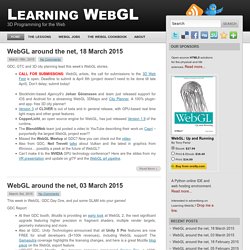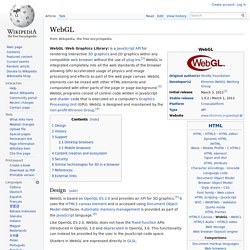

WebGL Stats. WebGL performance info. Learning WebGL. A year ago, at a biggest-ever, record-breaking HTML5 Meetup in San Francisco all about WebGL, I predicted we were a tipping point; I think I was right.

Let’s take a look at 2014, a banner year for 3D on the web! A Year of Great Content John Cale and Liam Young’s City of Drones brought together experiments in music and architecture; Isaac Cohen continued to blow minds with visualizations like Weird Kids and Webby; Google’s A Spacecraft for All chronicled the 36-year journey of the ISEE-3 space probe; and SKAZKA showed us an alternate world created by The Mill and powered by Goo. A Year of Killer Apps In 2014, WebGL made its mark– an indelible impression– on advertising, e-commerce, music, news and engineering. A Year of Pro Tools Goo, Verold, Turbulenz and PlayCanvas all made great strides with their WebGL engines and development environments.
A Year of Gaming WebGL is definitely up to the challenge of creating high-quality MMOs. A Year of Virtual Reality. PhiloGL: A WebGL Framework for Data Visualization, Creative Coding and Game Development. Javascript WebGL. WebGL Collada viewer. CubicVR 3D Engine. WebGL Globe. Best Of WebGL: Top 10 Experiments. Whether you are a professional web developer looking for inspiration or just a curious individual, here is something for your weekend: A collection of some of the best WebGL experiments out there, ranging from cool particle tricks to water physics simulation.

So, grab your popcorn and enjoy the show. Animated Volume Particles Azathioprine Attractors Trip Lights Pacmaze Pulpo Surface Voxels Liquid WebGL Globe WebGL Water For even more WebGL experiments, check the following post. Chrome Experiments - Home. Web GL test. WebGL - OpenGL ES 2.0 for the Web. The Khronos Group - Connecting Software to Silicon The Khronos Group is a not for profit industry consortium creating open standards for the authoring and acceleration of parallel computing, graphics, dynamic media, computer vision and sensor processing on a wide variety of platforms and devices.
All Khronos members are able to contribute to the development of Khronos API specifications, are empowered to vote at various stages before public deployment, and are able to accelerate the delivery of their cutting-edge 3D platforms and applications through early access to specification drafts and conformance tests. OpenGL - The Industry Standard for High Performance Graphics OpenGL® is the most widely adopted 2D and 3D graphics API in the industry, bringing thousands of applications to a wide variety of computer platforms. It is window-system and operating-system independent as well as network-transparent. OpenCL - The open standard for parallel programming of heterogeneous systems. WebGL: All about OpenGL ES 2.0 for the Web.
WebGL. Design[edit] Like OpenGL ES 2.0, WebGL does not have the fixed-function APIs introduced in OpenGL 1.0 and deprecated in OpenGL 3.0.

This functionality can instead be provided by the user in the JavaScript code space. Shaders in WebGL are expressed directly in GLSL. History[edit] WebGL evolved out of the Canvas 3D experiments started by Vladimir Vukićević at Mozilla. In early 2009, the non-profit technology consortium Khronos Group started the WebGL Working Group, with initial participation from Apple, Google, Mozilla, Opera, and others.[4][8] Version 1.0 of the WebGL specification was released March 2011.[1] As of March 2012, the chair of the working group is Ken Russell. Early applications of WebGL include Google Maps and Zygote Body.[9][10] More recently[when?] Development of the WebGL 2 specification started in 2013.[12] This specification is based on OpenGL ES 3.0.
Support[edit] WebGL is widely supported in modern browsers. Desktop browsers[edit] Mobile browsers[edit] Security[edit] WebGL Public Wiki.